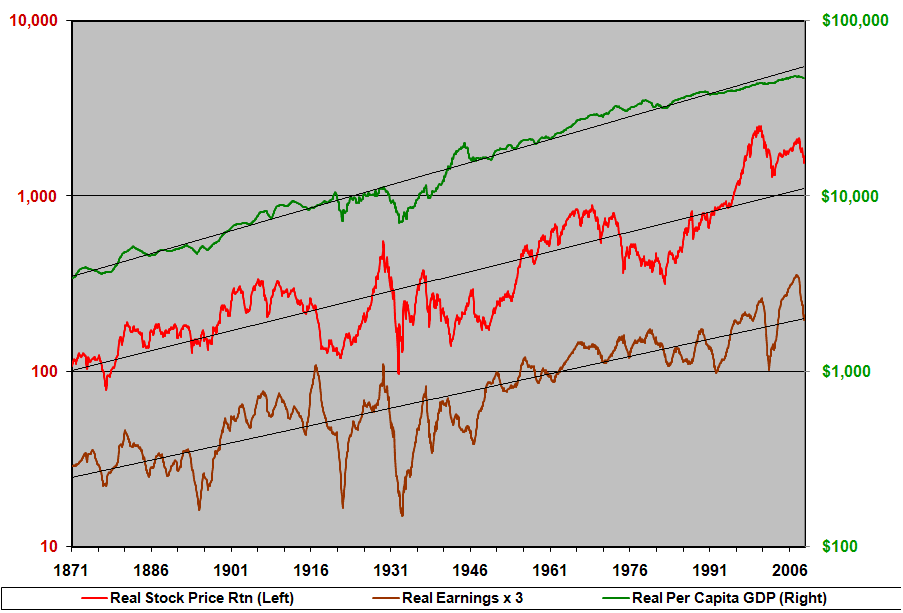The Basic Speed Law for Capital Markets Returns
Recent stock market behavior has been astonishing. Down 22 percent in the first half of October, down over 40% in the last twelve months. Much of this drop has been blamed on the current financial crisis, but there are deeper – and yet simpler – economic forces at work. Three truisms are too easily overlooked.
The first truism is that over the long-run real per capita economic growth in the United States, over and above inflation, has been remarkably steady at just under 2%, as the top line in the attached figure shows. Growth over the last 25, 50 and 100 years has averaged 1.4%, 1.7% and 1.9%, respectively. This real growth rate reflects improving productivity which over periods of decades varies very little. Share prices (the middle line) and per-share earnings for the broad market (the bottom line) exhibit much the same growth, albeit with much more variability.
One nuance that is often overlooked is, just as the economy is the shared production of a growing population, a growing roster of companies drives that economic growth. Entrepreneurial capitalism – new enterprise creation – is an important driver of economic growth, contributing roughly half of real GDP growth on average over time. The other half of overall real GDP growth is contributed by the growth of existing enterprises. This means that share prices and per-share earnings for broad indexes like the S&P 500 should match the growth of existing enterprises, roughly half of total GDP growth. As it happens, this growth closely mirrors per capita GDP growth.

The second truism is that if aggregate real per capita growth rate in the economy is a bit under 2%, the broadest sectors of the economy, like the corporate sector, have to deliver about the same per capita growth rate in the long run. If the growth rate were greater, that sector would eventually become larger than the entire economy, an outcome that is constrained by both economic and political forces.
Over the last several decades Americans at all levels in business, government and private life have behaved as if these first two truisms were no longer relevant. Implicitly, and in some cases explicitly, decisions were made, including investment decisions, that were based on the assumption of far greater growth. A common refrain was that even if real per capita growth in the aggregate economy is limited to about 2%, the latter number does not apply to us or to our investments, whether our domain is housing, technology stocks, hedge fund investments or the stock market.
The third truism is that valuation of long lived assets, like common stocks, are highly sensitive to the assumed rate of growth. The experience of Google is an obvious example. The stock price has plummeted to $330 from $750 despite continued impressive growth in earnings, because the earnings growth has not been fast enough to justify an initially-lofty multiple. Expectations for future growth have been continuously revised downward.
Applying these three facts to the market as a whole leads to several stark conclusions. First, as with any broad sector of the economy, corporate earnings are constrained by the same long run 2% limit. This means that, unless P/E ratios change, stock prices will also grow, on average, at no more than 2% in real terms for the truly long-term investor.
History supports this view. In the last 25, 50 and 100 years, real growth in S&P 500 per-share real earnings has averaged 3.2%, 2.0% and 1.5%, respectively. Meanwhile, the S&P 500 price index has risen by 5.1%, 2.7% and 1.9%, respectively, over and above inflation. The earnings have grown faster than per capita GDP growth in recent years, in large measure due to recent earnings that have subsequently proven illusory. Meanwhile, share prices have grown faster still, largely on the back of rising valuation multiples, which we dare not rely on in the future. This recent outsized growth in real per-share earnings and share prices, over and above the per capita real growth of the economy may be helping to foment the populist backlash we’re now seeing.
In this historical light, the current crisis is seen as more than simply the result of a housing bubble or an overstressed financial system. It is based on a widespread hubris that somehow the laws of economic growth do not apply, that share prices and earnings can grow faster than the overall economy. That hubris was reinforced by organizational structures that allowed executives, insurers, derivatives traders, bankers and many others to take large amounts of cash home as long as the euphoria continued, and as long as customers were willing to set aside logic in favor of a promised nirvana.
The ultimate return of stock prices to levels more consistent with economic growth is nothing more than another example of mean reversion at work. The good news is that, from current levels, mean reversion need not exact as severe a future toll as it has imposed on us in the last twelve months. This too shall pass.



